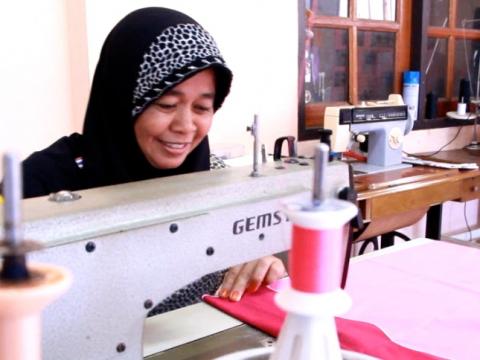Ancient art re-paints dark days

By: Jay Mark Mijares, Communications, World Vision Thailand
It is not unusual for mothers in the fishing and farming village of Ban Nai Rai to look for work in order to augment the husband’s income for the family. Yet when darker days hit the very core of existence, like when the tsunami struck in December of 2004, finding something to work on is a matter of life and death.
While many mourned for their loved ones who were among the 24,000 casualties from a single catastrophe, the community was also stripped of their main source of livelihood and suffered a great deal of trauma.
“We don’t want to remember and many of us don’t even want to talk about until now,” says Katiya Bomuang, a mother.
The pain of losing all was so great that it left a blank canvas in the minds of tsunami survivors in Ban Nai Rai village. Their small fishing boats, nets, homes, and dear ones – practically their entire life – was obliterated from the canvas that they were trying to paint.
Even today, most people prefer silence amidst the sensitivities of the topic.
All hope was not lost. Women are coming back with mighty brushes. Through the art and colours of Batik-making passed on to them by their ancestors as a hobby and cultural heritage, more than 25 women in the village are utilizing their brushes for a better world. They are painting the blank canvas anew for the next generation to witness.
Oozing with tears, a brave mother finally broke the deafening silence.
Hariam, 50 and a mother of five shares, “After the tsunami, many housewives here has no job. With the remaining wits in us we thought of what we need to do for our families in order to survive. Then the Royal Princess and World Vision provided the support that we need at that time as we moved to form a cooperative.”
In the Batik cooperative, beautiful signature designs from bright yellow, blue, red and a range of pastel dyes are applied into white cloth to produce stylish bags, pillow cases, and uniforms as a positive response to the tsunami.
“Before the tsunami, we go to other villages to work as sap gatherers on rubber tree plantations. When the news broke about the disaster, we scampered to come back as soon as we could to find out if our loved ones were safe,” Hariam recalls, “After the terrible things that we saw in the aftermath of the tsunami, everyone got scared and no one wanted to leave our homes and our children anymore.”
“[The Batik-cooperative] doubled our income. Housewives earn THB 10,000 [USD 304] per month today compared to THB 5,000 THB [USD 152] in our pre-tsunami days. We are happy that mothers like us have more money to use now for our children’s school needs and education,” says Hariam.
Yet something more has changed permanently in the halls and classrooms through the project. Flowers, fish, and unique lines are everywhere since everyone is donning a variety of shades of colours – a far cry from the usual blue and white or monotone ones from the old days.
“Every year big orders for students’ and teachers’ uniforms come from the schools here and the nearby villages. We presented colourful designs to them. They changed their uniforms to embrace our Batik shirts, and they've ordered in bulk once a year,” Hariam says. “As with other mothers, whenever I see my design worn by children and other people, happiness jumps up from within, it makes me want to do more.”
The dyeing craft breathed new life, not only as a source of alternative income, but as a ray of sunshine that illuminates a range of colours in the inner soul.
“When they see our design, good impression comes not only from our customers but people from outside,” Hariam adds. “Our play of colors is something that they don’t see in other places but here.”